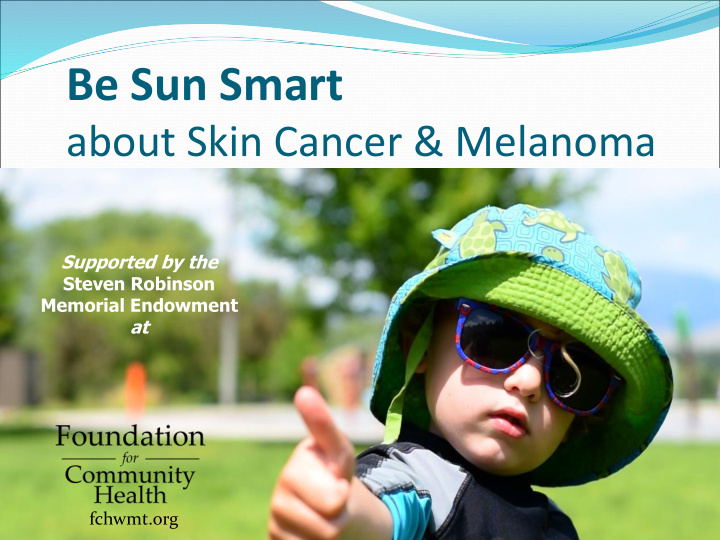



Be Sun Smart about Skin Cancer & Melanoma Supported by the Steven Robinson Memorial Endowment at fchwmt.org
Steven Robinson Steven Robinson Memorial Endowment at
Steven’s story Fair hair and skin Grew up around water and loved being outdoors Experienced several sunburns as a child and young adult Sunscreen wasn’t as promoted then Suffered a late diagnosis of melanoma Passed away in 2000 at the age of 35 Family established the Steven Robinson Memorial Endowment to promote skin cancer and melanoma awareness and prevention
Why we focus on melanoma Steven’s late diagnosis The number of new melanoma cases has more than doubled in the last 30 years; Montana’s rate is growing nearly seven times faster than US overall Every six minutes , one new case of melanoma could be diagnosed in the US this year One blistering sunburn when young can double a person's chances of developing melanoma; more sunburns, more risk Melanoma is the most common cancer for women age 25-29, and the second most common for age 15-29
One American dies of melanoma every hour
Sun… Friend or Foe? Both!
Effects of the sun HELPFUL HARMFUL Helps plants grow Can cause drought Keeps us warm Ultraviolet Rays Makes our skin age and Makes vitamin D wrinkle Kills germs Causes sunburns Makes us feel good Causes eye damage Gives us light Causes skin cancer Environmental Protection Agency
Three types of ultraviolet (UV) rays UVA : Present all year around, and all day. Pass through windows. Penetrate deeper into the skin than UVB rays. “ A ging rays” UVB : More intense in the summer, at higher elevations, and closer to the equator. “ B urning rays” UVC : The strongest and most dangerous UV rays. Filtered out by ozone layer.
UV rays - your exposure varies Time of day Season of the year Location Altitude Weather Reflection Ozone layer Good sense and protection are key!
Our Skin – let’s protect it! American Cancer Society, Inc.
Plan your day with the UV Index Visit https://www.epa.gov/sunsafety/uv-index-1 and pack appropriate protective gear
UV INDEX LOW MODERATE HIGH VERY HIGH EXTREME LEVEL 0-2 3-5 6-7 8-10 11 & more Action to Take: Average 60 45 30 15 10 Minutes to Skin Damage: Check out the UV Index at https://www.epa.gov/sunsafety/uv-index-1
Author: Thomas Leveritt
How about indoor tanning? Source of intense UVA and UVB radiation World Health Organization declared indoor tanning devices to be cancer-causing agents of the same category as tobacco. Using indoor tanning before age 35 can increase your risk of melanoma by 59% , and your risk increases with each use. Use can result in permanent skin damage American Academy of Dermatology
What happens when our skin gets sick? Skin cancer Disease of the DNA within skin cells Most common type of cancer in the United States - over last 30 years, more people have had skin cancer than all other cancers combined One in five Americans will develop skin cancer in their lifetime One in four is younger than 40 years old Each year, more than 5.4 million cases of skin cancers are treated in the United States Do you know someone with skin cancer?
Taking a closer look at skin cancer Three common types Squamous cell carcinoma Basal cell carcinoma Melanoma
Squamous cell carcinoma Tends to develop on skin that has been exposed to the sun for years
Basal cell carcinoma Most commonly diagnosed cancer (about 80% of cases) in the US
Melanoma One of the most serious and deadly forms of skin cancer, if not diagnosed and treated in time Originates in the pigment- producing melanocytes
Melanoma
Who is at greater risk? Exposed to excessive amounts of unprotected natural sunlight and/or indoor tanning Family or personal history of melanoma Multiple or unusual-looking moles Fair skin, blue, green or hazel eyes, red or blonde hair, and/or excessive freckling Traumatized skin sites such as major scars or burn areas Weakened immune system, especially after an organ transplant
Be watchful for melanoma May appear as a new mole, or in an existing mole or freckle that changes in color, size or shape Grows over weeks to months and may appear anywhere on the body, even in places not exposed to ultraviolet rays Can spread to other parts of the body, if not diagnosed and treated in time
The ABCDEs of Melanoma
A = A symmetry Is it Asymmetric ?
B = B order Is the Border irregular or poorly defined?
C = C olor Is it more than one Color ?
D = D iameter Is the Diameter larger than the size of a pencil eraser?
E = E volving Is it Evolving , changing in size, shape or color?
Melanoma in children can look different Often a single color, and not necessarily black or brown -- look for red, pink, purple or flesh-colored spot or growth Can present as a bleeding or itchy spot or growth Watch for an open sore that heals, then returns Rather than appearing flat, look for a bump that grows rapidly Also be watchful of a dark streak beneath a fingernail or toenail
Be a sun-smart example! Pack your sun-smart kit Keep an eye on your skin and the skin of others Lead by example with your family, friends, and those in your care
What is one thing you learned about Being Sun Smart today? What one new step will you take to Be Sun Smart ?
To help you remember
Other Sun-Smart Resources • Skin Cancer Foundation: skincancer.org • American Cancer Society: cancer.org • Sun Safety Program of the US Environmental Protection Agency: www.epa.gov/sunsafety • Sun AWARE program of the Children’s Melanoma Prevention Foundation: melanomaprevention.org • National Cancer Institute: cancer.gov • American Academy of Dermatology: aad.org • Environmental Working Group: ewg.org fchwmt.org
Thank you for being a Be Sun Smart partner! fchwmt.org/be-sun-smart-skin-cancer-awareness
Recommend
More recommend